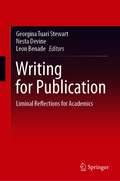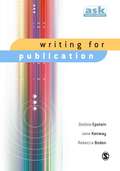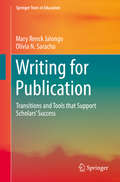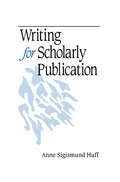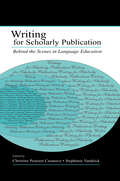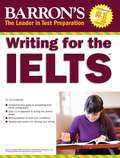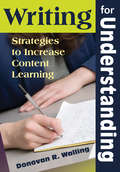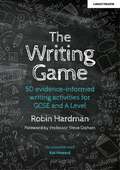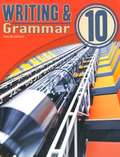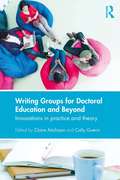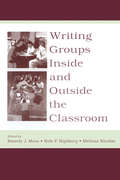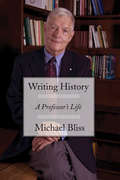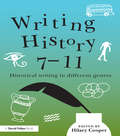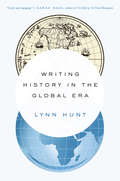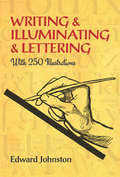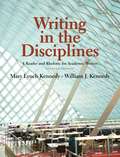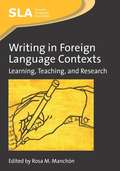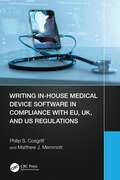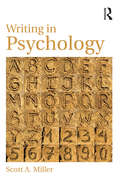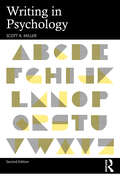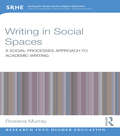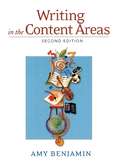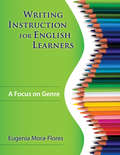- Table View
- List View
Writing for Publication: Liminal Reflections for Academics
by Leon Benade Georgina Tuari Stewart Nesta DevineThis book focuses on academic writing and how academics who are experts in their fields can translate their expertise into publishable form. The magnitude and speed of the changes that are transforming the global academic landscape produce an ongoing need for literature that interprets the nature of academic work. This book arises from the background discipline of Education, which is a relatively new university subject that draws on the entire knowledge spectrum from the fine arts to the natural sciences. Each chapter addresses an aspect of the conditions of written academic labour in an age of digital publishing: its nature, how it works, and guidance for successful navigation. This book will provide helpful guidance to graduate students, researchers and teachers in universities and higher education, who are united by the challenges of this new world of academic publishing.
Writing for Publication (The Academic's Support Kit)
by Debbie Epstein Jane Kenway Professor Rebecca BodenWriting for Publication deals with a number of generic issues around academic writing (including intellectual property rights) and then considers writing refereed journal articles, books and book chapters in detail as well as other, less common, forms of publication for academics. The aim is to demystify the process and to help you to become a confident, competent, successful and published writer.
Writing for Publication
by Mary Renck Jalongo Olivia N. SarachoThis book offers systematic instruction and evidence-based guidance to academic authors. It demystifies scholarly writing and helps build both confidence and skill in aspiring and experienced authors. The first part of the book focuses on the author's role, writing's risks and rewards, practical strategies for improving writing, and ethical issues. Part Two focuses on the most common writing tasks: conference proposals, practical articles, research articles, and books. Each chapter is replete with specific examples, templates to generate a first draft, and checklists or rubrics for self-evaluation. The final section of the book counsels graduate students and professors on selecting the most promising projects; generating multiple related, yet distinctive, publications from the same body of work; and using writing as a tool for professional development. Written by a team that represents outstanding teaching, award-winning writing, and extensive editorial experience, the book leads teacher/scholar/authors to replace the old "publish or perish" dictum with a different, growth-seeking orientation: publish and flourish.
Writing for Scholarly Publication
by Anne Sigismund HuffAcademic writing has its own ground rules and its own creativity. In this practical guide for students and academics, the author takes the reader step-by-step through the entire writing and publication process - from choosing a subject, to developing content, to submitting the final manuscript for publication. The book contains exercises, helpful checklists, exemplars and advice drawn from the author's experience.
Writing for Scholarly Publication
by Anne Sigismund HuffAcademic writing has its own ground rules and its own creativity. In this practical guide for students and academics, the author takes the reader step-by-step through the entire writing and publication process - from choosing a subject, to developing content, to submitting the final manuscript for publication. The book contains exercises, helpful checklists, exemplars and advice drawn from the author's experience.
Writing for Scholarly Publication: Behind the Scenes in Language Education
by Stephanie Vandrick Christine Pearson CasanaveThis collection of first-person essays by established authors provides a wealth of support and insights for new and experienced academic writers in language education and multicultural studies. Although writing for publication is becoming increasingly important as these fields become both more professional and more competitive, few scholars talk candidly about their experiences negotiating a piece of writing into print. These essays will help researchers, practitioners, and graduate students expand their understanding of what it means--professionally and personally--to write for publication. Carefully crafted, focused, and provocative, the chapters in this volume document authors' experiences with a range of practical, political, and personal issues in writing for publication. Many portray the hardship and struggle that are not obvious in a finished piece of writing. Readers are encouraged to resonate with the events and issues portrayed, and to connect the narratives to their own lives. Practical information, such as contact information for journal and book publishers, manuscript guidelines, and useful books are included in appendices. Although organized thematically, the essays in Writing for Scholarly Publication: Behind the Scenes in Language Education overlap in many ways as each author considers multiple issues: *In the Introduction, the editors discuss key aspects of writing for scholarly publication, such as writing as situated practice, issues faced by newcomers, the construction of personal identity through writing, writing and transparency, facets of the interactive nature of scholarly writing, and intertwined political issues. *Part I focuses on issues and concerns faced by "Newcomers." *In Part II, "Negotiating and Interacting," the essays closely examine the interactions among authors, editors, manuscript reviewers, and collaborators; these interactions tend to be the least often discussed and these essays therefore offer readers fascinating insights into the sensitive social, political, and personal relationships among the many players in the scholarly writing game. *"Identity Construction" is addressed in Part III, where authors share their experiences with and reflections on the ways that professional writing helps them construct their identities as writers and scholars. *The essays in Part IV, "From the Periphery," help redefine what the notion of "periphery" might mean, from a concept with a negative connotation of "outsider" to a positive connotation of active and unconventional participant.
Writing for the IELTS
by Lin LougheedDiscover everything you’ll need to know in order to write well for the IELTS test, whether you are planning to take the Academic or the General Training version. This book will help IELTS test takers learn several essential skills, including:Task Achievement: follow a three-step model to plan, write, and revise your essaysCoherence and Cohesion: practice organizing your writing and connecting ideasLexical Resource: build your vocabulary and use it correctlyGrammatical Range and Accuracy: review rules and practice applying them to your writingEach section leads you step-by-step through the process of writing an essay in response to a particular task. Learn how to apply what you’ve learned, familiarize yourself with the types of questions you’ll have to respond to on the test, complete your responses within the time limits, and more. An Appendix also includes a More Writing Practice section with a selection of essays written in response to IELTS writing tasks.
Writing for Understanding: Strategies to Increase Content Learning
by Donovan R. WallingWritten specifically for non–language arts teachers, this resource focuses on using writing as an instructional tool to deepen and expand student understanding in the content areas.
The Writing Game: 50 Evidence-Informed Writing Activities for GCSE and A Level
by Robin HardmanAs every humanities or social science teacher knows, success in exam years relies on pupils’ ability to blend subject knowledge with writing skills. But teachers face two significant problems in developing writing in their classroom: many pupils regard writing practice as a chore or a punishment; and research on writing instruction remains difficult for busy teachers to access. The Writing Game: 50 Evidence-Informed Writing Activities for GCSE and A Level aims to solve these problems by providing a must-read practical toolkit for teachers looking to help their pupils to write their way into the top grades, offering a menu of engaging lesson activities that can be modified to suit any subject context. With activities covering modelling, practice, and feedback, The Writing Game supports teachers to deliver research-informed strategies at every stage of the learning process. Perfect for teachers, middle leaders, and senior leaders, The Writing Game also contains tips on how to incorporate writing practice into regular subject content, formative assessment, and retrieval practice. Each activity is fully explained and accompanied by top tips for maximising effective learning, suggested adaptations, and links to appropriate research. Activities range from rapid five-minute starters and plenaries to whole-lesson extended writing tasks, with plenty in between, and busy teachers will be relieved to hear that many require very little preparation.
The Writing Game: 50 Evidence-Informed Writing Activities for GCSE and A Level
by Robin HardmanAs every humanities or social science teacher knows, success in exam years relies on pupils’ ability to blend subject knowledge with writing skills. But teachers face two significant problems in developing writing in their classroom: many pupils regard writing practice as a chore or a punishment; and research on writing instruction remains difficult for busy teachers to access. The Writing Game: 50 Evidence-Informed Writing Activities for GCSE and A Level aims to solve these problems by providing a must-read practical toolkit for teachers looking to help their pupils to write their way into the top grades, offering a menu of engaging lesson activities that can be modified to suit any subject context. With activities covering modelling, practice, and feedback, The Writing Game supports teachers to deliver research-informed strategies at every stage of the learning process. Perfect for teachers, middle leaders, and senior leaders, The Writing Game also contains tips on how to incorporate writing practice into regular subject content, formative assessment, and retrieval practice. Each activity is fully explained and accompanied by top tips for maximising effective learning, suggested adaptations, and links to appropriate research. Activities range from rapid five-minute starters and plenaries to whole-lesson extended writing tasks, with plenty in between, and busy teachers will be relieved to hear that many require very little preparation.
Writing & Grammar Grade 10 Student Text (Fourth Edition)
by Bob Jones UniversityThis updated fourth edition of BJU Press' Writing and Grammar, Grade 10 student text features full-color pages with historical examples and context from all eras. Charts, sample sentences, enrichment focusing on thinking skills and Bible letters, and ESL notes all provide additional insights and interest to the chapter's primary focus. Lessons feature an excerpt, grammar exercises, and writing activities. This grade 10 text covers parts of speech, sentences, phrases, clauses, agreement, verb use, pronoun reference, capitalization, punctuation, writing, library skills, study skills, and more.
Writing Groups for Doctoral Education and Beyond: Innovations in practice and theory
by Claire Aitchison and Cally GuerinWriting is the principal means by which doctoral candidature is monitored and measured; this, combined with the growing tendency to use publications as proxy measures of individual and institutional productivity, underlines the centrality of writing in academia. One of the central questions for scholars in higher education, therefore, is ‘How do we make writing happen?’, and it is this question which the book seeks to answer. The book provides detailed illustrations of collaborative writing pedagogies which are powerfully enabling, and through theoretical and conceptual interrogation of these practices, the authors point the way for individuals as well as institutions to establish writing groups that are lively, responsive and context-specific. Key topics include: new pedagogical responses for increased writing productivity and the ‘push to publish’; innovations for supporting academic writing quality, confidence and output; scaffolding the thesis writing process; new theoretical explorations of collaborative writing approaches; writing group formulations and pedagogical approaches; writing groups for non-native speakers of English; writing as women in higher education. A particular strength of this book is that it showcases the potential of writing groups for advanced academic writing by pulling together a unique mix of authors and scholarly approaches, representing a wide range of new theoretical and pedagogical frames from diverse countries. Writing Groups for Doctoral Education and Beyond will be attractive to academics seeking new ways to advance their writing productivity, doctoral students, their supervisors and those who are tasked with the job of supporting them through the completion and dissemination of their research.
Writing Groups Inside and Outside the Classroom (International Writing Centers Association (IWCA) Press Series)
by Beverly J. Moss Nels P. Highberg Melissa NicolasThis unique collection considers the nature of writing groups inside and outside the academic environment. Exploring writing groups as contextual literacy events, editors Beverly J. Moss, Nels P. Highberg, and Melissa Nicolas bring together contributors to document and reflect on the various types of collaborations that occur in writing groups in a wide range of settings, both within and outside the academy. The chapters in this volume respond to a variety of questions about writing groups, including: *What is the impact of gender, race, and socioeconomic class on power dynamics in writing groups? *When is a writing group a community and are all writing groups communities? *How does the local community of a writing group impact the participation of group members in other local or global communities? *How does the local community of a writing group impact the participation of group members in other local or global communities? *What actions contribute to a strong community of writers and what actions contribute to the breakdown of community? *When and for whom are writing groups ineffective? *What is it about belonging to a community of writers that makes writing groups appealing to so many within and beyond the academy?Each chapter highlights how writing groups, whether or not they are labeled as such, function in various spaces and locations, and how collaboration works when writers from a variety of backgrounds with diverse interests come together. Writing Groups Inside and Outside the Classroom illustrates that writing groups outside of the academy are worthy of study and serve as important sites of writing and literacy instruction. Offering significant insights into the roles of writing groups in literacy and writing practice, this volume is appropriate for scholars and teachers of writing, rhetoric, composition, and literacy; for writing center administrators and staff; and for writing group participants.
Writing History: A Professor’s Life
by Michael BlissOne of Canada’s best-known and most-honoured biographers turns to the raw material of his own life in Writing History. A university professor, prolific scholar, public intellectual, and frank critic of the world he has known, Michael Bliss draws on extensive personal diaries to describe a life that has taken him from small-town Ontario in the 1950s to international recognition for his books in Canadian and medical history. His memoir ranges remarkably widely: it encompasses social history, family tragedy, a critical insider’s view of university life, Canadian national politics, and, above all, a rare glimpse into the craftsmanship that goes into the research and writing of history in our time. Whether writing about pigs and millionaires, the discovery of insulin, sleazy Canadian politicians, or the founders of modern medicine and brain surgery, Michael Bliss is noted for the clarity of his prose, the honesty of his opinions, and the breadth of his literary interests.
Writing History 7-11: Historical writing in different genres
by Hilary CooperWriting History 7-11 supports students and primary teachers helping them to explore ways in which activities involving the talk that underpins historical enquiry can be developed into reading and exciting, extended, reflective writing. The step that teachers and pupils take from ‘talk for learning’ to ‘talk for writing’ is a vital one. In this book the authors argue that all aspects of historical enquiry leading to writing involve discussion and dialogue which permeate every aspect of ‘doing history’. From this perspective they set out a theoretical framework for understanding the role of talk and reading in developing pupils’ critical thinking and confident reflective writing, then demonstrate through a series of case studies, in which teachers, university lecturers and pupils work together, how the theory is put into practice in the classroom. Themes include: How to support children in writing in a variety of interesting genres How to make links between the National Curriculum (2013) for History and for English How to plan for breadth and depth studies in the new National Curriculum How activities in History 5 – 11 can be developed into exciting extended writing The second half of the book draws upon case studies from a number of real primary classrooms with children of different ages. Each case study shows how teaching was planned to develop children’s confidence and enjoyment in discussion and to scaffold reasoned, written explanation and argument. Topics presented are all relevant to the new curriculum framework and include talking and reading about: Time, change and significance over 6000 years - writing a television script Celtic Britain and the Roman Army - writing a travel brochure about Celtic Britain The destruction of Roman towns - writing a Saxon poem An archaeological investigation of a body in a Danish peat bog - writing a newspaper report Did any countries benefit from WW11? - writing an argued viewpoint The expansion westwards of European settlers - writing a flap book exploring different perspectives. This indispensable book provides not only sources for pupils to use in their writing, but also models and exemplars of different styles and voices to draw upon.
Writing History in the Global Era
by Lynn HuntLeading historian Lynn Hunt rethinks why history matters in today's global world and how it should be written. George Orwell wrote that "history is written by the winners." Even if that seems a bit too cut-and-dried, we can say that history is always written from a viewpoint but that viewpoints change, sometimes radically. The history of workers, women, and minorities challenged the once-unquestioned dominance of the tales of great leaders and military victories. Then, cultural studies--including feminism and queer studies--brought fresh perspectives, but those too have run their course. With globalization emerging as a major economic, cultural, and political force, Lynn Hunt examines whether it can reinvigorate the telling of history. She hopes that scholars from East and West can collaborate in new ways and write wider-ranging works. At the same time, Hunt argues that we could better understand the effects of globalization in the past if we knew more about how individuals felt about the changes they were experiencing. She proposes a sweeping reevaluation of individuals' active role and their place in society as the keys to understanding the way people and ideas interact. She also reveals how surprising new perspectives on society and the self--from environmental history, the history of human-animal interactions, and even neuroscience--offer promising new ways of thinking about the meaning and purpose of history in our time.
Writing & Illuminating & Lettering: With 250 Illustrations
by Edward JohnstonOne of the founders of modern calligraphy, Edward Johnston regarded lettering, writing, and illuminating as not only desirable ends in themselves but also as practical avenues to mastery of typography, decoration, and design. In this classic, profusely illustrated guide, he distilled his expertise into a series of easy-to-follow lessons that will benefit any student of calligraphy, book design, or art.Part I is devoted to writing and illuminating. Early chapters cover the fundamentals of acquiring a formal hand: choosing paper, ink, and quills; holding the pen; spacing and planning a manuscript; and more. The author then turns to the techniques of producing a manuscript book: tools and materials, methods and proportions, margins, and other methods. Part II offers a detailed discussion of lettering: the qualities of good lettering, methods of construction and arrangement, spacing, proportion, and other matters. Two appendixes cover the uses of lettering in book bindings, wall inscriptions, monograms, and title pages as well as the techniques involved in lettering on metal, wood, and stone.
Writing In The Disciplines: A Reader And Rhetoric For Academic Writers
by Mary Lynch Kennedy William J. KennedyThis rhetoric/anthology instructs college students in how to read academic texts with understanding and how to use them as sources for papers in a variety of disciplines. <P><P>In Writing in the Disciplines, Mary Kennedy and William Kennedy emphasize academic writing as ongoing conversations in multiple genres, and do so in the context of WPA Outcomes. <P><P>The rhetoric chapters teach critical reading, paraphrasing, summarizing, quoting, writing process, synthesizing, analyzing, researching, and developing arguments. <P><P>The anthology balances journal articles with works by public intellectuals in the sciences, social sciences, and humanities.
Writing in Foreign Language Contexts
by Rosa ManchonThis book represents the most comprehensive account to date of foreign language (FL) writing. Its basic aim is to reflect critically on where the field is now and where it needs need to go next in the exploration of FL writing at the levels of theory, research, and pedagogy, hence the two parts of the book: 'Looking back' and 'Looking ahead'. The chapters in Part I offer accounts of both the inquiry process followed and the main insights gained in various long-term research programs. The chapters in Part 2 contribute a retrospective analysis of the available empirical research and of professional experiences in an attempt to move forward. The book invites the reader to step back and rethink seemingly well established knowledge about L2 writing in light of what is known about writing in FL contexts.
Writing In-House Medical Device Software in Compliance with EU, UK, and US Regulations
by Philip S. Cosgriff Matthew J. MemmottThis book is a comprehensive guide to producing medical software for routine clinical use. It is a practical guidebook for medical professionals developing software to ensure compliance with medical device regulations for software products intended to be sold commercially, shared with healthcare colleagues in other hospitals, or simply used in-house.It compares requirements and latest regulations in different global territories, including the most recent EU regulations as well as UK and US regulations.This book is a valuable resource for practising clinical scientists producing medical software in-house, in addition to other medical staff writing small apps for clinical use, clinical scientist trainees, and software engineers considering a move into healthcare. The academic level is post-graduate, as readers will require a basic knowledge of software engineering principles and practice.Key Features: Up to date with the latest regulations in the UK, the EU, and the US Useful for those producing medical software for routine clinical use Contains best practice
Writing in Psychology
by Scott A. MillerThis book helps readers become better writers of psychology and better writers in general. After reading thousands of course papers, theses, and dissertations, Dr. Miller knows and addresses the issues that students find most challenging when writing about psychology. Written with the utmost flexibility in mind, the chapters can be read in any order. More comprehensive than similar texts, this book provides detailed coverage of how to write empirical reports, research proposals, and literature reviews, and how to read meta-analyses. Readers will also find invaluable strategies for improving one’s writing including how to adopt an engaging yet accurate style, thorough coverage of grammatical and word use rules that govern writing in general, and the APA (American Psychological Association) rules that govern the expression of that content. Readers will appreciate these helpful learning tools: Describes the most common APA style rules encountered and/or highlights references to the Manual when more detailed knowledge is required. Numerous examples from journal articles that help readers gain a clearer understanding of content they will encounter in writing psychological reports. Chapter exercises that provide an opportunity to apply the points conveyed in each chapter. Examples of the most common mistakes made by students and how to avoid them and best practices for improving one’s writing. Tables that help readers gain a clearer understanding of the new standards in the APA Publications Manual, 6th ed (Appendix A). Errors in APA Style exemplified via an improperly formatted paper and another version noting corrections pertaining to APA style and grammar, to highlight the most common pitfalls encountered by students (Appendix B). Ideal for courses on writing in psychology or as a supplement for graduate or advanced undergraduate courses in research design or research methods, this book also serves as a resource for anyone looking for guidance on how to write about psychological content.
Writing in Psychology
by Scott A. MillerThe second edition of Writing in Psychology by Scott A. Miller is a comprehensive guide to addressing the most challenging issues that students face while writing about psychology, including what to say and how to say it. It offers practical tools to overcome the challenges and create an engaging work. The book is a valuable resource for helping readers become better writers of psychology with the aid of various helpful learning tools, which provide detailed coverage of how to write empirical reviews, research proposals, literature reviews, term papers, and posters. It examines examples from journal articles that give readers a grasp of the content they will encounter in writing psychological reports. Furthermore, it includes exercises that provide an opportunity to apply the points conveyed in each chapter, examples of ways to avoid the most common mistakes made by students, and a guide to the best practices for improving one’s writing. Readers will also develop a thorough understanding of how to write in an engaging yet accurate style, using grammatical and word use rules that govern writing in general, and the rules of seventh edition APA (American Psychological Association) Publication Manual that determine the expression of that content. Throughout, the book emphasizes inclusion, diversity, and fair treatment of those with whom psychologists deal, in research and writing. The book will benefit anyone looking for guidance on how to write about psychological content. It is ideal for research scholars and psychology students as a primary text for writing in psychology courses and a supplement for graduate or advanced undergraduate courses in research design or research methods.
Writing in Social Spaces: A social processes approach to academic writing (Research into Higher Education)
by Rowena MurrayWriting in Social Spaces addresses the problem of making time and space for writing in academic life and work of the professionals and practitioners who do academic writing'. Even those who want to write, who know how to write well and who have quality publications, report that they cannot find enough time for writing. Many supervisors are unsure about how to help postgraduates improve their writing for thesis and publication. Whilst the problem does presents through concerns with ‘time’, it is also partly about writing practices, academic identities and lack of motivation. This book provides a research-based, theorised approach to the skill of writing whilst retaining a link to writing practices and giving immediate yet sustainable solutions to the writing problem. It supplies new theory and practice on: socializing writing-in-progress and writing with others exploring the alternation of conscious and unconscious, internal and external processes in academic writing whilst in a social grouping Applying social processes in the writing process Using case studies and vignettes of writing in social spaces to illustrate the theory in practice, This book is a valuable resource for academics, scholars, professionals and practitioners, as well as researchers at all stages of their career, and in all disciplines.
Writing in the Content Areas
by Amy BenjaminDo you spend entirely too much time correcting your students' papers? Do your students' essays and term papers take side trips to nowhere? Is their writing riddled with mechanical errors? Do their lab reports and essays lack specificity and clarity? Writing in the Content Areas, Second Edition is for middle and high school content area teachers who assign essays, term papers, lab reports, and other writing tasks to students. This book provides strategies and tips to help teachers of social studies, science, art, etc. improve the quality of students' writing and apply national and state curriculum standards in your classroom. The strategies in this book can be integrated easily into every teacher's daily plans. They will help your students improve their abilities to - reflect before writing - organize and classify - provide detail without padding - use technical terminology correctly - avoid unnecessary words - spell correctly- take useful notes while they read and during your lectures.This book will help teachers - get what they want from a writing task - frame their assignments more precisely - correct student papers more quickly and efficientlyThe new second edition offers activities and strategies which involve technology (word processing, presentation programming, the Internet, and e-communications), differentiated instruction, and brain-based learning.
Writing Instruction for English Learners: A Focus on Genre
by Eugenia R. Mora-FloresFocusing on narrative, expository, and persuasive writing and poetry, this guide provides strategies and tools to facilitate writing development for English learners in Grades 2–8.
